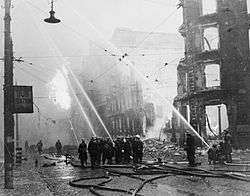Manchester Blitz
The Manchester Blitz (also known as the Christmas Blitz) was the heavy bombing of the city of Manchester and its surrounding areas in North West England during the Second World War by the German Luftwaffe. It was one of three major raids[lower-alpha 1] on Manchester, an important inland port and industrial city; Trafford Park in neighbouring Stretford was a major centre of war production.

Raids on Manchester
Air raids began in August 1940, and in September 1940 the Palace Theatre on Oxford Street was bombed. The heaviest raids occurred on the nights of 22/23 and 23/24 December 1940, killing an estimated 684 people and injuring more than 2,000.[1] Manchester Cathedral, the Royal Exchange and the Free Trade Hall were among the large buildings damaged. On the night of 22/23 December 272 tons of high explosive were dropped, and another 195 tons the following night. Almost 2,000 incendiaries were also dropped on the city over the two nights.[1] The aircraft spread fanwise over the city and adopted the by then familiar tactic of dropping flares followed by incendiaries and high explosives with later waves targeting the fires caused by the earlier attacks. There were other less intensive bombing raids across Britain [2] and two German aircraft were reported to have been lost over the British Isles on 24 December; one crashed in the sea near Blackpool and the other, loaded with incendiaries and flares, crashed in flames near Etchingham, Sussex with no survivors.[3]
Salford and Stretford
Neighbouring Salford, Stretford and other districts were also badly damaged by the bombing. It is estimated that more than 215 people were killed and 910 injured in Salford, and more than 8,000 homes were damaged or destroyed.[1] Seventy-three were killed in Stretford, and many more were injured.[4] On 11 March 1941, Old Trafford football stadium was hit during an air raid that lasted 3 hours as German bombers aimed for the industrial complex of Trafford Park. Rebuilding of the stadium commenced after the end of the war and Manchester United returned to a rebuilt stadium in 1949, having played at Manchester City's Maine Road stadium in the meantime.
In June 1941 German bombs damaged the original Salford Royal Hospital on Chapel Street at the junction with Adelphi Street, killing 14 nurses.
Further raids
On 11 March 1941 Old Trafford football stadium, the home of Manchester United F.C., was hit by a bomb aimed at the industrial complex of Trafford Park, wrecking the pitch and demolishing the stands. The stadium was rebuilt after the war and reopened in 1949, until which time United played at Manchester City's Maine Road stadium.[5]
In June 1941 German bombs damaged the police headquarters. Manchester continued to be bombed by the Luftwaffe throughout the war, and became the target of airborne V-1 flying bombs. On Christmas Eve 1944, Heinkel He 111 bombers flying over the Yorkshire coast launched 45 flying bombs at Manchester. No V-1s landed in Manchester itself, but 27 people in neighbouring Oldham were killed by a stray bomb. Another 17 people were killed elsewhere and 109 wounded overall. RAF De Havilland Mosquitos shot down one German bomber over the North Sea and severely damaged another, causing it to crash land in Germany.[6]
See also
References
Notes
- A major raid is one in which 100 or more tons of high explosive are dropped.[1]
Citations
- Mason, Amanda. "The Manchester Blitz". Imperial War Museum. Retrieved 19 November 2007.
- Anon (23 December 1940). "Two German planes shot down;Building damaged by fire". Derby Daily Telegraph. Retrieved 27 January 2018.
- Anon (24 December 1940). "Manchester gets its first big bombing". Daily Mirror. Retrieved 27 January 2018.
- Masterson & Cliff (2002), p. 156.
- "Archived copy". Archived from the original on 1 January 2012. Retrieved 30 December 2011.CS1 maint: archived copy as title (link)
- "V1 attack on Manchester, Christmas Eve 1944". 25 April 2011. Retrieved 19 November 2017.
Bibliography
- Masterson, Vicki; Cliff, Karen (2002). Stretford: An Illustrated History. The Breedon Books Publishing Company. ISBN 978-1-85983-321-6.CS1 maint: ref=harv (link)
Further reading
- Daily Dispatch and Evening Chronicle (1945) Our Blitz: Red Sky over Manchester. Manchester: Kemsley Newspapers (Facsimile edition by Aurora Publishing, Bolton, [ca. 2000] ISBN 978-1-85926-049-4).